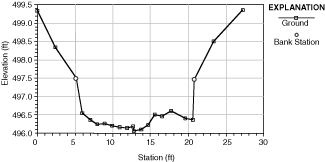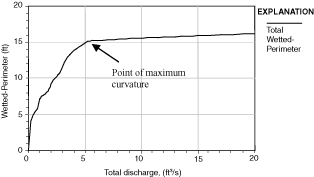METHODS FOR DETERMINING STREAMFLOW REQUIREMENTS FOR HABITAT PROTECTION
The preliminary results of this study include determinations of streamflow requirements for habitat protection at critical riffle sites. Two standard-setting methods were used. These methods are the R2Cross method (Espegren, 1996, 1998; Nehring, 1979) and the Wetted-Perimeter method (Nelson, 1984; Leathe and Nelson, 1986).
The R2Cross and Wetted-Perimeter methods require site-specific physical and hydraulic data at a riffle section, such as channel geometry, average velocity, and mean depth over a range of discharges. An advantage of the R2Cross and Wetted-Perimeter methods is that they are based upon field observations and do not require data from a streamgaging station, so the streamflow requirements obtained by these methods can be applied in hydrologically disturbed drainage basins and at gaged or ungaged sites.
Care must be taken, however, to choose sites that are representative of natural riffle conditions. A riffle is a section of channel, usually between pools, that has a gravel to cobble bed material. The water surface is turbulent with little or no whitewater having average water velocities in the range of 0.6 ft/s to 1.6 ft/s (Bain and Stevenson, 1999). Appropriate riffles for application of the R2Cross and Wetted-Perimeter methods extend across the entire channel, are well defined, and maintain hydraulic control over a range of low to moderate flows. Differences in channel geometry among riffles can create variability in resulting streamflow requirements. For example, reaches that have large boulders or woody debris in the channel that lengthen the flow path or altered streambeds or banks that narrow or widen a natural channel should be avoided. Alterations to channels can have a direct effect on the streamflow recommendations. The artificial widening or narrowing of stream channels can affect wetted perimeter, mean velocity, and mean depth values at a site. The reinforcement of stream banks and streambeds with riprap prevents natural width and depth adjustments. Consequently, streamflow requirements determined for natural riffle sites may not be sufficient to protect habitat at sites in a widened channel, and flow requirements estimated at sites with a narrowed channel may not provide sufficient flows for habitat protection in unaltered stream reaches.
R2Cross Method
The R2Cross method requires selection of a critical riffle along a stream and assumes that a discharge chosen to maintain habitat in the riffle is sufficient to maintain habitat for fish in nearby pools and runs for most life stages of fish and aquatic invertebrates (Nehring, 1979). Streamflow requirements for habitat protection in riffles are determined from flows that meet criteria for three hydraulic parameters: mean depth, percent of bankfull wetted perimeter, and average water velocity (table 2). The hydraulic criteria used in the R2Cross method were developed in Colorado to quantify the amount of streamflow required to "preserve the natural environment to a reasonable degree" (Espegren, 1996). The R2Cross method has been found to produce flow recommendations that are similar to those determined by more data intensive techniques such as the Instream-Flow Incremental Methodology (Nehring, 1979; Colorado Water Conservation Board, 2001).
| Table 2. R2Cross
hydraulic criteria for protection of aquatic habitat [Source: Espegren, 1996. ft, foot; ft/s, foot per second; >or equal to] |
||||||
| Stream top width (ft) | Mean depth (ft) | Bankfull wetted perimeter (percent) | Mean velocity (ft/s) | |||
|---|---|---|---|---|---|---|
|
1–20
|
0.2
|
50
|
1.0
|
|||
|
21–40
|
0.2–0.4
|
50
|
1.0
|
|||
|
41–60
|
0.4–0.6
|
50–60
|
1.0
|
|||
|
61–10
|
0.6–1.0
|
> or equal to 70
|
1.0
|
|||
To account for seasonal streamflow variability, the R2Cross method establishes different streamflow requirements for the summer and winter seasons. Initial streamflow recommendations in Colorado are based upon the streamflow that meets all three hydraulic criteria during its high-flow period in summer and two of three hydraulic criteria during its low-flow period in winter. In contrast to Colorado, Massachusetts's flows are generally lowest in mid-summer and early fall (July through September). For this study, streamflow recommendations were established at flows that meet all three R2Cross hydraulic criteria. Streams in Massachusetts have additional stresses during the summer months that are linked to low streamflows, such as high stream temperatures and low dissolved-oxygen concentrations. Meeting all three R2Cross hydraulic criteria will result in more conservative streamflow requirements (Annear and Conder, 1984).
Wetted-Perimeter Method
The Wetted-Perimeter method assumes that there is a direct relation between the wetted perimeter in a riffle and fish habitat in streams (Annear and Conder, 1984; Lohr, 1993). The wetted perimeter of a stream, defined as the width of the streambed and stream banks in contact with water for an individual cross section, is used as a measure of the availability of aquatic habitat over a range of discharges (Annear and Conder, 1984; Nelson, 1984). The Wetted-Perimeter method is based on a plot of the relation between wetted perimeter and discharge (fig. 2). The point of maximum curvature in this relation is used to determine the streamflow required for habitat protection. On a stream cross section, this point theoretically corresponds to the break in slope at the bottom of a stream bank where the water surface would begin to recede in a more horizontal direction from the stream banks when flows are decreasing, or to rise up the banks when flows increase. On plots of wetted perimeter versus discharge, the breaks in slope on such graphs are most distinct in riffle channels with rectangular or trapezoidal cross sections. In these cases, water levels that rise above the bottom of the bank cause smaller rates of increase in wetted perimeter for each unit increase of discharge; water levels that fall below the bottom of the bank cause larger rates of decrease in wetted perimeter for each unit decrease in discharge.
 |
 |
| Figure 2. (A) Stream channel for cross section 173.65 and (B) relation between wetted perimeter and discharge at Mine Brook near Franklin, Massachusetts. |
Stream-channel geometry varies considerably, and the effectiveness of the Wetted-Perimeter method can be highly dependent upon the cross sections selected in the field. In practice, there is seldom a single break in slope in the wetted-perimeter-to-discharge relation. Many conditions contribute to multiple breaks in slope or the lack of a distinct breakpoint. Multiple breakpoints can correspond to water rising over different features of the channel such as bars or boulders or an irregular channel bed or banks. Less-well-defined breakpoints also may be a function of the number, density, and location of points surveyed along a cross section. For this study, several detailed cross sections were surveyed at each riffle site. Care was taken to survey points along the cross section that corresponded to changes in slope of the streambeds and banks. The elevations of the bottoms of the stream banks that corresponded to a fully wetted channel were identified during surveying. These elevations were used to aid in determination of streamflow requirements for cross sections with no clearly discernible breakpoints or with multiple breakpoints in the wetted-perimeter-to-discharge relation.
Water-Surface-Profile Modeling
A water-surface-profile model, the U.S. Army Corps of Engineers, Hydrologic Engineering Center's River Analysis System (HEC-RAS; Brunner, 2001), was used in this study to simulate the water-surface profile for each riffle site and to determine the hydraulic parameters required for application of both the R2Cross and Wetted-Perimeter methods. HEC-RAS is designed to perform one-dimensional hydraulic calculations for a network of natural or constructed channels under steady or gradually varying flow. The computational procedure is based on the solution of the one-dimensional energy equation from one stream section to the next. Energy losses are evaluated by friction (Manning's equation) and contraction or expansion (coefficient multiplied by the change in velocity head) (Brunner, 2001). Once calibrated, HEC-RAS results were summarized in a table of stage, estimating average depth, average velocity, and percent bankfull wetted perimeter for a range of discharges.
Next: Preliminary streamflow requirements for habitat protection
Previous: Introduction
